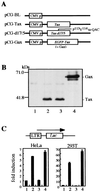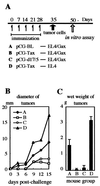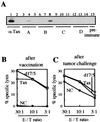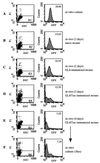Mouse model for the equilibration interaction between the host immune system and human T-cell leukemia virus type 1 gene expression
- PMID: 11861837
- PMCID: PMC135962
- DOI: 10.1128/jvi.76.6.2703-2713.2002
Mouse model for the equilibration interaction between the host immune system and human T-cell leukemia virus type 1 gene expression
Abstract
To study the involvement of immune responses against Tax of human T-cell leukemia virus type 1 (HTLV-1) in the growth of and gene suppression in Tax-expressing tumor cells in vivo, we established a model system involving C57BL/6J mice and a syngeneic lymphoma cell line, EL4. When mice were immunized by DNA-based immunization with Tax expression plasmids, solid tumor formation upon subcutaneous inoculation of EL4 cells expressing green fluorescent protein-fused Tax (Gax) under the control of the HTLV-1 enhancer was strongly inhibited, and in vitro analysis showed that DNA immunization elicited cytotoxic T-lymphocyte (CTL) responses but not production of antibodies to Tax protein. Since EL4/Gax cells inoculated into DNA-immunized mice were not completely eradicated but were maintained as small solid tumors for a long period, there appeared to be a certain equilibrium between CTL activity and the growth of Gax-expressing cells. With such a balance, expression of the Gax gene in EL4/Gax cells was strongly suppressed. These results suggested that gene expression under the control of the HTLV-1 long terminal repeat and Tax is silenced in vivo, resulting in an equilibrium between viral expression and the host immune system. Such a balance would represent a status of persistent infection by HTLV-1 in virus-infected individuals during the latency period.
Figures








Similar articles
-
Prevention of adult T-cell leukemia-like lymphoproliferative disease in rats by adoptively transferred T cells from a donor immunized with human T-cell leukemia virus type 1 Tax-coding DNA vaccine.J Virol. 2000 Oct;74(20):9610-6. doi: 10.1128/jvi.74.20.9610-9616.2000. J Virol. 2000. PMID: 11000233 Free PMC article.
-
Activation and detection of HTLV-I Tax-specific CTLs by epitope expressing single-chain trimers of MHC class I in a rat model.Retrovirology. 2008 Oct 8;5:90. doi: 10.1186/1742-4690-5-90. Retrovirology. 2008. PMID: 18840303 Free PMC article.
-
Involvement of TORC2, a CREB co-activator, in the in vivo-specific transcriptional control of HTLV-1.Retrovirology. 2009 Aug 11;6:73. doi: 10.1186/1742-4690-6-73. Retrovirology. 2009. PMID: 19664292 Free PMC article.
-
Latency Reversing Agents: Kick and Kill of HTLV-1?Int J Mol Sci. 2021 May 24;22(11):5545. doi: 10.3390/ijms22115545. Int J Mol Sci. 2021. PMID: 34073995 Free PMC article. Review.
-
Immunological risks of adult T-cell leukemia at primary HTLV-I infection.Trends Microbiol. 2004 Jul;12(7):346-52. doi: 10.1016/j.tim.2004.05.005. Trends Microbiol. 2004. PMID: 15223062 Review.
Cited by
-
Molecular determinants of human T-lymphotropic virus type 1 transmission and spread.Viruses. 2011 Jul;3(7):1131-65. doi: 10.3390/v3071131. Epub 2011 Jul 12. Viruses. 2011. PMID: 21994774 Free PMC article. Review.
-
Stromal cell-mediated suppression of human T-cell leukemia virus type 1 expression in vitro and in vivo by type I interferon.J Virol. 2009 May;83(10):5101-8. doi: 10.1128/JVI.02564-08. Epub 2009 Mar 4. J Virol. 2009. PMID: 19264779 Free PMC article.
-
Animal models for human T-lymphotropic virus type 1 (HTLV-1) infection and transformation.Oncogene. 2005 Sep 5;24(39):6005-15. doi: 10.1038/sj.onc.1208974. Oncogene. 2005. PMID: 16155607 Free PMC article. Review.
-
De novo human T-cell leukemia virus type 1 infection of human lymphocytes in NOD-SCID, common gamma-chain knockout mice.J Virol. 2006 Nov;80(21):10683-91. doi: 10.1128/JVI.01009-06. Epub 2006 Aug 30. J Virol. 2006. PMID: 16943297 Free PMC article.
-
Critical role for TSLC1 expression in the growth and organ infiltration of adult T-cell leukemia cells in vivo.J Virol. 2008 Dec;82(23):11958-63. doi: 10.1128/JVI.01149-08. Epub 2008 Oct 15. J Virol. 2008. PMID: 18922876 Free PMC article.
References
-
- Abe, J., H. Wakimoto, Y. Yoshida, M. Aoyagi, K. Hirakawa, and H. Hamada. 1995. Antitumor effect induced by granulocyte/macrophage colony-stimulating factor gene-modified tumor vaccination: comparison of adenovirus- and retrovirus-mediated genetic transduction. J. Cancer Res. Clin. Oncol. 121:587-592. - PubMed
-
- Ballard, D. W., E. Bohnlein, J. W. Lowenthal, Y. Wano, B. R. Franza, and W. C. Greene. 1988. HTLV-I tax induces cellular proteins that activate the κB element in the IL-2 receptor α gene. Science 241:1652-1655. - PubMed
-
- Cann, A. J., J. D. Rosenblatt, W. Wachsman, N. P. Shah, and I. S. Chen. 1985. Identification of the gene responsible for human T-cell leukaemia virus transcriptional regulation. Nature 318:571-574. - PubMed
-
- Chen, I. S., A. J. Cann, N. P. Shah, and R. B. Gaynor. 1985. Functional relation between HTLV-II x and adenovirus E1A proteins in transcriptional activation. Science 230:570-573. - PubMed
Publication types
MeSH terms
Substances
LinkOut - more resources
Full Text Sources

